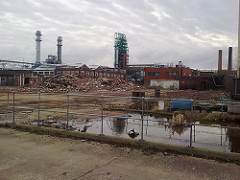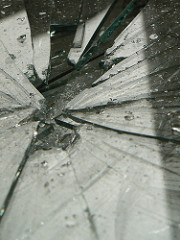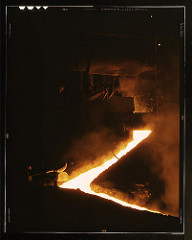Solid and Hazardous Waste Management
Unlock all answers in this set
Unlock answersquestion
brownfield

answer
land previously used for industrial purposes or some commercial uses
question
cullet

answer
recycled broken or waste glass used in glass making
question
dioxins
answer
family of 75 chlorinated hydrocarbon compounds formed as unwanted by-products in chemical reactions involving chlorine and hydrocarbons, usually at high temperatures; serious and persistent
question
environmental justice
answer
fair treatment and meaningful involvement of all people regardless of race, color, sex, national origin, or income with respect to the development, implementation, and enforcement of environmental laws, regulations, and policies
question
leachate
answer
water that has percolated through solid and leached out some of the constituents
question
mine tailing
answer
(also called mine dumps, culm dumps, slimes, tails, refuse, leach residue, or slickens): are materials leftover after the process of separating the valuable fraction from the uneconomic fraction (gangue) of an ore
question
open dumps
answer
fields or holes in the ground where garbage is deposited and sometimes covered with soil. They are rare in developed countries, but are widely used in many developing countries, especially to handle wastes from megacities
question
PCB's
answer
(polychlorinated biphenyls): group of 209 toxic, oily, synthetic chlorinated hydrocarbon compounds that can be biologically amplified in food chains and webs
question
refuse
answer
waste (leftover matter without further use) that can be processed to become something new
question
slag

answer
stony waste matter separate from metals during the smelting or refining of ore
question
tipping fee (gate fee)
answer
changes levied upon given quantity of waste received at a waste processing facility
question
waste stream
answer
aggregate flow of waste material from generation to treatment to final disposition
question
Industrial waste
answer
produced by mines, agriculture, and industries [that supply people with goods and services] -most of waste products are deposited and processed on site rather than being transferred to a different location for disposal -Ex: iron tailing ( from main in MT), copper slag (by product of smelting copper), coal (fly) ash (when burning coal some of it released in air)
question
Municipal Solid Waste
answer
collected from households, small businesses, schools, prisons, municipal buildings, and hospitals -(According to EPA) ~60% of MSW comes from residents and 40% comes from commercial and institutional facilities -Ex: cans, plastics, e-waste
question
Hazardous (toxic) waste
answer
hazardous if ignitable, corrosive, reactive, or toxic waste material that is harmful to humans and/or ecosystems -majority is by-product of industrial processes like the cleaning of machinery and manufacturing of computer equipment. However, some hazardous wastes may originate from small businesses like dry cleaning and automobile service stations -Ex: car batteries, motor oil, window cleaners, paints, household pesticides, dry cleaning solution, oven cleaner, wood preservatives, flea powders, tank cleaners, sunblock?
question
How many pounds of MSW does the average american generate?
answer
4.5 lbs.
question
what percentage of MSW is dumped, recycled (or composted), or burned?
answer
50% dumped 30% recycled or composted 20% burned in incinerators
question
We could reuse or recycle what percentage of MSW that we produce?
answer
90%
question
(T or F): The United States produces about half of the world's solid waste.
answer
False, U.S. produces 1/3
question
Basel Convention
answer
regulates/ prevents movement of waste to other lands (March 1989) -152 countries in it -United states, Haiti, and Afghanistan not included
question
E-waste

answer
consists of discarded television sets, cellphone, computers, e-toys, and other electronic devices. Most of it ends up in landfills and incinerators. These are made up of high-quality plastics, Al, Cu, Nickel, Platinum, Ag, Au but also PVC (polyvinylchloride), brominated frame retardants, Pb, and Hg. 70% goes to China, rest to India and poor African Nations.
question
what is an advantage and disadvantage of sending scrap to poorer nations?
answer
adv: cheap labor, Workers (many children) dismantle products for valuable metals and reusable parts dis: weak environmental regulations, remaining scrap is dumped in waterways and fields or burned in open fires -->exposes man people to toxic dioxins
question
Name ways e-waste disposal is improving
answer
Massachusetts and 5 other states ban disposal of computers and t.v. sets in landfills - some e-manufactures have free recycling programs - some e-manufacturers arrange for pickups or paying for shipping costs
question
Solid Waste Management
answer
involves managing wastes to reduce their environmental harm without seriously trying to reduce the amount of waste produced -Ex: Hawaii sent trash to mainland due to limited land area *reduce harm not amount
question
Basic Design of Landfills
answer
-bottom of landfill is lined with plastic sheets and compacted with clay to prevent leachate from contaminating the groundwater -underneath the landfill: system of pipes that collects leachate -solid waste lining: waste spread out in thin layers, compacted, and covered with a fresh layer of clay or plastic foam on a regular basis (usually daily) -cap: made of soil, clay (and sometimes plastic) is installed over the landfill to encourage water flow instead of into landfill
question
Why is clay used to line landfills?
answer
clay impedes the flow of water and retains positively charged ions
question
What are the advantages of covering the waste with clay and plastic?
answer
-keeps material dry - reduces leakage of contaminated water -reduces risk of fire -reduces odor -reduces accessibility to vermen
question
ideal site for landfills
answer
-area rich in clay soil -area located away from rivers, streams, and drinking water supplies -can be too close to people (odor/NIMBY) or too far (hauling releases more CO2 and more energy costs)
question
Advantages of landfills
answer
low operating costs - no open burning - built quickly -can handle large amounts of waste - filled land can be used for other purposes - low ground water pollution (if sited properly) -no shortage of landfill space in many areas - little odor
question
Disadvantages of landfills
answer
noise and traffic -output approach that encourages waste production - dust - air pollution from toxic gases and trucks -releases greenhouse gases [methane and CO2] *unless collected -slow decomposition of waste -eventually leaks and can contaminate groundwater
question
Difference between sanitary landfill and open dump
answer
open dump: uncovered site without environmental controls, susceptible to burning and scavengers , no lining
question
(T or F): Open dumps are popular in developed countries
answer
false, rare in developed countries
question
Landfill methane capture
answer
methane released when trash decomposes; when caught and burned they use it for energy
question
Incineration
answer
process of burning waste materials to reduce volume (90%) and mass (75%) -Waste-to-energy incinerators burn solid wastes and recover some of the energy produced to use for heating water or producing electricity
question
Ash
answer
non-organic particulates that do not combust during incineration -Ash particulates can be collected by the Baghouse filter but not methane or CO2
question
what's the difference between bottom and fly ash?
answer
bottom ash is residue collected underneath the furnace -fly ash: collected beyond the furnace
question
How do you dispose of ash?
answer
if it is non-toxic then if goes to the landfill. If toxic, the is goes to a hazardous waste facility.
question
Advantages of Incinerators
answer
reduce trash volume -less need for landfills - low water pollution - concentrates hazardous substances into ash for burial - sale of energy reduces costs - modern controls reduces air pollution - some facilities recover and sell metals
question
Disadvantages of incinerators
answer
-expensive to build -some air pollution and CO2 emissions -output approach that encourages waste production -costs more than short distance hauling to landfills -difficult to site because of citizen opposition -older or poorly managed facilities can release large amounts of air pollution -can compete with recycling for burnable materials such as newspaper
question
name 2 largest classes of hazardous wastes
answer
organic: (pesticides, PBC's, dioxins) inorganic: heavy metals (PB, Hg, As)
question
ways to treat hazardous waste
answer
-use charcoal or resins (sticky substance made from trees) -distill liquid mixtures to separate out harmful chemicals -use magnetic nanoparticles (nanomagnets) coated with certain compounds to remove various pollutants from water - chemical reactions to convert hazardous chemicals harmless or less harmful chemicals -bioremediation -phytoremediation -incineration -plasma arc torch
question
bioremediation
answer
use bacteria or enzymes to help destroy toxic waste or convert them to harmless compounds. (there are over 1000 different types of bacteria and fungi that have been used to detoxify waste.) -takes longer but cost less *can be used for oil spills
question
Phytoremediation
answer
use natural or genetically engineered plants to absorb, filter, and remove contaminants from polluted soil and water -easy to establish -inexpensive -low energy use -some toxic organic chemical may evaporate from plant leaves -slow and only effective at the depth of the plant roots -take several growing seasons -produce little air pollution compared to incineration Ex: plants can take mercury out of soil but now have mercury in them thus most be disposed of
question
Incineration (treatment for hazardous waste)
answer
heating many types of H waste (ip to 2000 C) can break them down and convert them to less harmful or harmless chemicals - produces dioxins and highly toxic ash (stored in safe and permanent landfill or vault designed for storing H waste)
question
Plasma Arc torch
answer
-passing electric current through a gas to generate an electric arc and very high temperatures (creating plasma) - plasma: ionized gas that is made up of electrically conductive ions and electrons -no toxic ash -greenhouse gases released
question
The U.S. stores hazardous and toxic waste _____ because _____
answer
-in burial on land or long term storage (should be a last resort - it's cheap
question
name the 4 ways to storage hazardous waste
answer
-deep well disposal - surface impoundments - long term retrievable storage - secure hazardous waste landfill
question
deep well disposal
answer
involves pumping liquid hazardous waste into dry porous rock that are found far beneath aquifers - limited number of sites that will work for this method - any unexpected leaks can contaminate ground or surface water
question
surface impoundments
answer
excavated depressions (such as ponds, pits, or lagoons) into which liners are placed and liquid hazardous wastes are stored - water evaporates --> waste settles and becomes more concentrated - not too expensive - leaks can contaminate ground water and flooding can lead to over flow (especially if on a hill)
question
Long term retrievable storage
answer
used to store highly toxic materials (like Hg) that cannot be detoxified or destroyed - stored in drums -drums inspected on regular basis
question
Secure Hazardous Waste Landfill
answer
hazardous waste stored in drums -drums are buried - most expensive - site carefully designed and monitored -only 23 in the US
question
RCRA ( Resource Conservation and Recovery Act)
answer
EPA sets standards for managing different types of waste - permits: issued to dispose and dispose of certain waste in acceptable ways - cradle-to-grace system: track waste from production to disposal* *must submit proof of disposal to EPA -only 5% of waste produced is regulated under this law
question
CERCLA (Comprehensive Environmental Response, Compensation, and Liability Act)
answer
aka Superfund -identifies and cleans areas contaminated by hazardous waste -law DESIGNED to have POLLUTERS pay for cleaning up abandoned hazardous waste sites - taxes imposed on chemical and petroleum industries - Superfund now broke: taxpayers are ow paying most of the bill -think LOVE CANAL!
question
What was the love canal situation about?
answer
Hooker Chemical Industry bought the Love Canal ( the projected was stopped) and dumped its waste. Once filled and covered up they sold it to the Niagara Falls School Board (they need to expand school) for $1 and a warning of the chemicals. The school bought it either way and built a playground on it. Later houses were built adjacent to the canal. Blizzard and raining made the waste peculate up. There were +400 chemicals (Pb and Ag). People noticed sickness in children and there was an odor. People had to be evacuated (first wave was of 500 people and later evacuated another wave of 500). Superfund helped clean it up. They tore down the houses and used them to cover the landfill.
question
Brownfield Program
answer
set up by EPA -assists state and local gov. in cleaning up brownfields - Brownfields (Ex: factories, junkyards, gas stations, or older landfills) do not qualify for Superfund Program - sometimes incentives offered if developers convert areas into living or retail space
question
Reuse
answer
involves cleaning and using materials over and over which incr. typical life span of product - saves matter and energy resources -cut pollution -saves money Ex: refillable water bottles, bring own grocery bags, rechargeable batteries, buy used furniture, clothes, or donate clothing *Reusing can be hazardous in developing countries for poor individuals who scavenge in open dumps. They can be exposed to dioxins or infectious diseases
question
Recycling
answer
conserving resources by converting them into new products - saves matter resource, energy resource, cut pollution, generation jobs/ revenues, and reduces unsightly and environmentally harmful litter
question
Closed Loop Recycling (primary)
answer
materials recycled into new products of the same type -Ex: aluminum cans recycled to make new aluminum cans
question
Secondary Recycling (open loop)
answer
waste materials converted into new products
question
Name examples of Secondary Recycling
answer
tires--> shredded --> rubberized road surfacing -newspapers -->cellulose insulation - fly ash--> bricks
question
Preconsumer (internal waste)
answer
waste generated by manufacturing processes
question
Postconsumer (external waste)
answer
waste generated by consumer use of products
question
What are the 2 types of waste that can be recycled?
answer
preconsumer and postconsumer
question
criteria required by gov. for landfills
answer
built away from faults, wetlands, flood plains, or other restricted areas -prevent leachate from contaminating groundwater - ground water monitoring requirements -closure and postclosure care requirements -provide funding for environmental protection during and after landfill closure
question
What method of MSW and HW contributes to least increasing global climate?
answer
deep well injection
question
(T or F): Incandescent light bulbs are considered MSW
answer
True, Fluorescent bulbs are Hazardous because of the mercury content
question
Hazardous waste is classified by what two criteria?
answer
organic (like organic pesticides) or inorganic (heavy metal)
question
Paper products
answer
U.S. recycles 56% of paper and paperboard - Denmark recycles 97% -Recycled paper: uses 64% less energy, produces 35% less waste, 74% of less air pollution than from making paper from wood - paper puts out toxic compound chlorine dioxide used for bleaching/whitening paper
question
Glass
answer
U.S. recycles 36% of its glass container - cost less to recycle glass than make new - mixed colored glass cullet used for glassphalt which is glass/asphalt mixture
question
Name two examples of open loop recycling involving glass
answer
glass cullet can be made to make light reflectors on road - can be used to make counter tops
question
Aluminum
answer
most recycled material because of $ - making new can from old cans takes a fraction of energy -highest energy savings -leads to less pollution - 2/3 of cans recycled = 19 million barrels of oil annually
question
Plastic #1 (PET)
answer
Polyethylene terephthalate -make soft drink and drink bottles and peanut butter jars - recycled into fiberfill for sleeping bags, carpet fibers, and pillows
question
Plastic #2 (HDPE)
answer
high density polyethylene -make milkjugs, butter tubs, detergent bottles, motor oil bottles - recycled into flowerpots, trashcans, traffic barriers cones, detergent bottles -thicker material
question
Plastic #3 (PVC)
answer
polyvinyl chloride - make shampoo, cooking oil bottles, forks, fast-food service items -difficult to recycle and toxic
question
Plastic #4 (LDPE)
answer
low-density polyethylene - grocery bags, bread bags, shrink wrap - shouldn't throw away - take to recycling center
question
Plastic #5 PP (Polypropylene)
answer
yogurt containers, straws, pancake syrup bottles, bottle caps - make into car battery cases and manhole steps
question
Plastic #6 PS (Polystyrene)
answer
-disposable hot cups, packaging materials (peanuts), meat trays - recycle into lumber, cassette tape boxes, flower pots -do not put into recycling bin
question
Plastic #7 other
answer
mixture of various plastics like squeeze ketchup bottles and microwaveable dishes
question
Why is recycling chemically and economically difficult?
answer
difficult to isolate different plastics from other wastes - recovering individual plastic resins does not yield much material - new technology is making plastic biodegradable (need moisture and oxygen to break down) - cost of virgin plastic resins is lower than recycled resins due to low fossil fuel costs - uses energy and generates pollution for recycling
question
Economically speaking, it often__ to recycle products than to bury them in areas with ample landfill space
answer
more - especially if plastic
question
Composting
answer
form of recycling that focuses on natures recycling of nutrients - allows bacteria to recycle yard trimmings, food scarps, and other biodegradable organic waste (newspaper ) - organic waste comprise over 1/2 of solid waste -aerates soil and improves soils ability to retain nutrients and water
question
bottle bills
answer
charge you 3 cents for waterbottles and pay you back 3 cents if you recycle - areas that have this have more recycling done int here areas
question
what do you need for compost?
answer
green material: high in nitrogen, grass clippings/ leaves/ weeds, kitchen scraps (nothing greasy; you can put in banana peels or eggshells but not peanut butter), -brown material: high in carbon, paper, sawdust, newspaper, branches,twigs -water -air:over turn the compost with shovel or backyard composter drum
question
NOPE
answer
not on planet earth
question
Environmental justice movement
answer
movement to avoid discrimination of cleaning up communities. -whiter communities tend to be cleaned up faster and more completely than sites in African American and Latino communities have -studies have shown that a disproportionate share of polluting factories, hazardous waste dumps, incinerators and landfill in U.S. are located in African Americans, Asian Americans, Latinos, and Native Americans and working poor
question
POPS
answer
persistent organic pollutants - 122 countries completed to global treaty to control 12 POPS (seek to ban or phase out these chemicals and to detoxify/ isolate stockpiles) - allows 25 countries to use DDT to combat malaria until alt. found (U.S. not ratified treaty) -toxic, persistent, fat soluble , travel through wind and water -list of 12 called Dirty Dozen: include DDT, 8 other chlorine containing persistent pesticides, PCB's, furans, dioxins -every person on earth has detectable levels of POPS (long term effects are unknown)
question
Swedish parliament planning to enact law by 2020 to...
answer
assume chemicals guilty until proven innocent
question
Key principles
answer
everything is connected - dilution is not always the solution to pollution - polluters and producers should pay for the wastes they produce -different categories of hazardous waste and recyclable waste should not be mixed - mimic nature: reuse, recycle, compost atleast 75% os sold waste - best and cheap way --> waste reduction and pollution prevention



